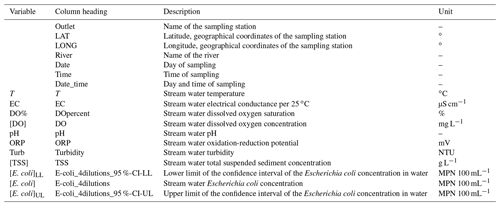the Creative Commons Attribution 4.0 License.
the Creative Commons Attribution 4.0 License.
Escherichia coli concentration, multiscale monitoring over the decade 2011–2021 in the Mekong River basin, Lao PDR
Laurie Boithias
Olivier Ribolzi
Emma Rochelle-Newall
Chanthanousone Thammahacksa
Paty Nakhle
Bounsamay Soulileuth
Anne Pando-Bahuon
Keooudone Latsachack
Norbert Silvera
Phabvilay Sounyafong
Khampaseuth Xayyathip
Rosalie Zimmermann
Sayaphet Rattanavong
Priscia Oliva
Thomas Pommier
Olivier Evrard
Sylvain Huon
Jean Causse
Thierry Henry-des-Tureaux
Oloth Sengtaheuanghoung
Nivong Sipaseuth
Alain Pierret
Bacterial pathogens in surface waters may threaten human health, especially in developing countries, where untreated surface water is often used for domestic needs. The objective of the long-term multiscale monitoring of Escherichia coli ([E. coli]) concentration in stream water, and that of associated variables (temperature (T), electrical conductance (EC), dissolved oxygen concentration ([DO]) and saturation (DO%), pH (pH), oxidation-reduction potential (ORP), turbidity (Turb), and total suspended sediment concentration ([TSS])), was to identify the drivers of bacterial dissemination across tropical catchments. This data description paper presents three datasets (see “Data availability” section) collected at 31 sampling stations located within the Mekong River and its tributaries in Lao PDR (0.6–25 946 km2) from 2011 to 2021. The 1602 records have been used to describe the hydrological processes driving in-stream E. coli concentration during flood events, to understand the land-use impact on bacterial dissemination on small and large catchment scales, to relate stream water quality and diarrhea outbreaks, and to build numerical models. The database may be further used, e.g., to interpret new variables measured in the monitored catchments, or to map the health risk posed by fecal pathogens.
- Article
(895 KB) - Full-text XML
- BibTeX
- EndNote
Bacterial pathogens, including fecal bacteria, are etiological agents of several waterborne diseases such as diarrhea. Primary sources of fecal bacteria in the environment are cattle droppings or human feces, where open defecation is practiced or where sanitation systems are lacking or deficient (Exley et al., 2015; Tong et al., 2016; Rochelle-Newall et al., 2015). Fecal bacteria may threaten human health if present in surface water, especially in developing countries where the population often uses untreated surface water for domestic needs (Boithias et al., 2016; Vos et al., 2020).
Prior to 2010, to our knowledge, no data had been published to document the occurrence of fecal indicator bacteria (FIB), such as Escherichia coli (E. coli), in stream water of rural, tropical catchments, such as the area of the 800 000 km2 Mekong River basin. Besides, very little information existed on microbial contamination and dissemination mechanisms in tropical environments. Accordingly, our research group initiated the systematic monitoring of surface water quality in 2011, focusing on Lao PDR, a landlocked country that contributes 41 % and 54 % of the total Mekong River flow during the dry and the rainy seasons, respectively (MRC, 2009), and where about 67 % of the population lives in rural areas (Lao Statistics Bureau, 2015).
The objective of the spatial and temporal monitoring of E. coli ([E. coli]) concentrations in stream water, and that of associated physicochemical measurements (i.e., temperature (T), electrical conductance (EC) at 25 ∘C, dissolved oxygen concentration ([DO]) and saturation (DO%), pH (pH), oxidation-reduction potential (ORP), turbidity (Turb), and total suspended sediment concentration ([TSS])), was to understand bacterial fate and transport, and underlying drivers, during storm and inter-storm flow periods within tropical catchments. The study design included three monitoring scales:
-
A spatial survey was conducted during both the dry and the rainy seasons in the Mekong River (six sampling stations) and its tributaries (23 sampling stations) across Lao PDR. The survey aimed to assess the spatial variability of instream E. coli concentration at large spatial scales (239–25 946 km2 for the tributaries, up to 549 055 km2 for the Mekong River itself), during both low-flow and high-flow periods. Grab samples were collected twice: in March and July of 2016.
-
A temporal monitoring at the outlet of six catchments (six sampling stations) in the mountainous area of northern Lao PDR was initiated in 2011, to assess the temporal variability of instream E. coli concentration at large spatial scales (239–25 946 km2 for the tributaries, up to 272 155 km2 for the Mekong River itself), during both low-flow and high-flow periods. Grab samples were first collected with a biweekly time interval, thereafter modified to a 10 d time interval in 2017.
-
A temporal monitoring at the outlet of a 0.6 km2 headwater catchment (one sampling station) in the mountainous area of northern Lao PDR was initiated in 2011, which aimed to understand the dynamics and the drivers of E. coli dissemination during low-flow and flood events. Grab samples were collected during low-flow periods with a biweekly time interval, thereafter modified to a 10 d time interval in 2017. During flood events, water sample collections were made with an automatic sampler triggered by water level change.
2.1 Study site
The Mekong River basin has experienced a dramatic economic and population growth over the past half-century, increasing pressure on land, water, and other natural resources (Pokhrel et al., 2018; Arias et al., 2014; Global Water Forum, 2015). Rapid land-use change, such as deforestation (Lyon et al., 2017) and conversion from traditional slash-and-burn agricultural systems to tree plantations (Ribolzi et al., 2017), has put soil fertility, agricultural productivity, and biodiversity conservation at stake (MA, 2005). Since the 1970s, dams have been constructed on the Mekong River and its tributaries (WLE, 2017), leading to severe impacts on hydrology (Le Meur et al., 2021; Hecht et al., 2019), on sediment transport (Kondolf et al., 2014; Shrestha et al., 2018), and on aquatic biodiversity (Sabo et al., 2017) in a climate change context.
The 31 sampling stations (Fig. 1, Table 1) of this dataset are located in Lao PDR, within the Mekong River basin. The choice of sampling stations in the Mekong River tributaries was made to encompass a broad range of catchment sizes (0.6–25 946 km2), and a large range of geological, topographical, and land-use features. In Lao PDR, the tropical climate (i.e., wet and dry (Aw) climate) is under the influence of the monsoon regime, dividing the year into two seasons: a dry season lasting from October to April, and a rainy season lasting from May to October. The average annual rainfall in Lao PDR varies from 1300 to 2500 mm and can exceed 3500 mm in central and southwestern Lao PDR (Nakhle et al., 2021b).
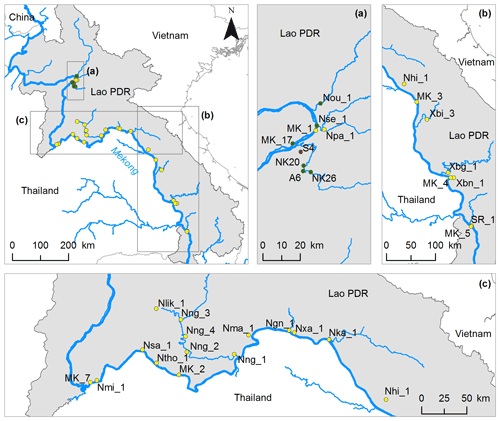
Figure 1Location of the 31 sampling stations within the Mekong River basin in Lao PDR. Tributary names and catchment areas are given in Table 1. Red dot represents sampling station S4 and green dots represent sampling stations NK20, NK26, A6, Nou_1, Nse_1, and MK_17.
Table 1Description of the 31 sampling stations within the Mekong River basin in Lao PDR: sampling station name, river name, geographical coordinates of sampling station (i.e., latitude and longitude in degrees, WGS 1984), sampling period, and catchment drainage area in km2.
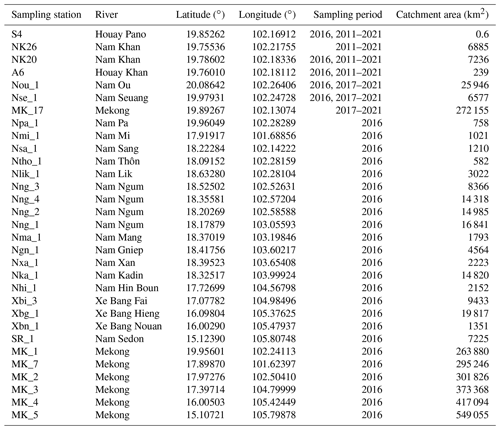
The 0.6 km2 Houay Pano headwater catchment (station S4) is located in northern Lao PDR, 10 km south of Luang Prabang city (Fig. 1a). This experimental site (Boithias et al., 2021b) is part of the Multiscale TROPIcal CatchmentS Critical Zone Observatory (M-TROPICS CZO; https://mtropics.obs-mip.fr/, last access: 21 June 2022), a network of observatories under the French Research Infrastructure OZCAR (Gaillardet et al., 2018). This catchment is representative of the montane agro-ecosystems of Southeast Asia. Altitude within the catchment is 435–716 m (Fig. 1b) and the slope gradient is 1 %–135 % (mean = 52 %). Over the last decade, land-use change in the catchment mostly consisted of an increase of teak tree plantations at the expense of shifting cultivation (with the slash-and-burn method). Overall, the areal percentage of annual crops decreased from 28 % to virtually zero, while the areal percentage of teak tree plantations increased from 17 % to 33 % from 2011 to 2021.
2.2 Data collection
The dataset comprises E. coli concentrations ([E. coli]) with lower and upper limits of the confidence interval ([E. coli]LL and [E. coli]UL, respectively), and physicochemical measurements in stream water, recorded from 25 May 2011, to 25 May 2021. Physicochemical measurements include T, EC at 25 ∘C, [DO] and DO%, pH, ORP, Turb, and [TSS]. The units of the 11 variables are given in Table 2.
For the spatial survey during both the dry and the rainy seasons, we chose sampling sites so as to ensure a broad geographical coverage of Lao PDR, and to represent a large range of geological, topographical, and land-use features. We also chose the sampling sites for being accessible from the road, in order to achieve the sampling campaign within a relatively short time.
For the temporal monitoring, we initiated the sampling at stations S4, NK20, NK26, and A6, in May 2011 with a biweekly time interval, changed to a 10 d time interval in 2017. We initiated the monitoring at stations Nou_1, Nse_1, and MK_17 in July 2017 according to the 10 d time interval.
At station S4, we collected water samples during flood events using an automatic sampler (Automatic Pumping Type Sediment Sampler, ICRISAT). The automatic sampler was triggered by a water level recorder to collect water after every 2 cm water level change during flood rising and every 4 cm water level change during flood recession. We measured EC, DO%, [DO], pH, and ORP once back at the laboratory, within 6 h after automatic sampling, with a portable multi-probe system (YSI 556), and Turb with a portable turbidity meter (EUTECH Instruments TN-100). A maximal storage duration of 6 h ensured that [E. coli] variation was not significant before laboratory analysis (Nakhle et al., 2021a).
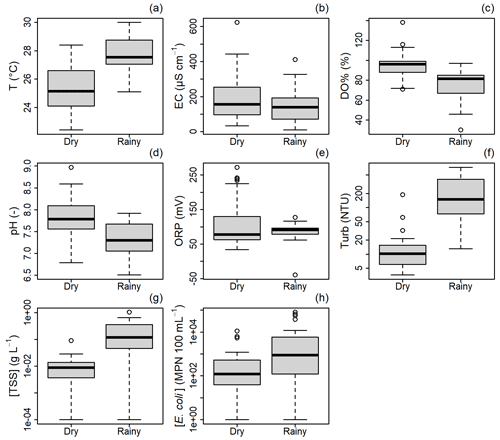
Figure 2Stream water quality during dry and rainy seasons in 2016 along the Mekong River (six sampling stations) and in 19 of its tributaries (23 sampling stations) in Lao PDR. T: temperature (∘C); EC: electrical conductance at 25 ∘C (µS cm−1); DO%: oxygen saturation (%); pH: pH (–); ORP: oxidation-reduction potential (mV); Turb: turbidity (NTU); [TSS]: total suspended sediment concentration (g L−1); [E. coli]: Escherichia coli concentration (MPN 100 mL−1). Turb, [TSS], and [E. coli] are shown with y axis as log scale. We added 0.0001 and 1 to all [TSS] and [E. coli] values, respectively, to present 0 values in a log scale, by convention.
At the other stations, and at station S4 during low flow, we manually sampled water with a bailer sampler and measured in situ T, EC, DO%, [DO], pH, and ORP, with the multi-probe system, and Turb with the turbidity meter. Bailer-sampled water was typically collected 5–10 m from the stream bank, except for station S4 where water was collected in the middle of the stream, about 0.5 m from the stream bank, and for stations MK_17, MK_3, and MK_5, where we used a boat to collect the water sample in the middle of the stream. We stored water samples in clean plastic bottles in an opaque icebox until laboratory analysis within 6 h.
We measured [E. coli] in the laboratory with the standardized microplate method (ISO 9308-3). For each water sample, we incubated a water subsample at four dilution rates (i.e., 1:2, 1:20, 1:200, and 1:2000) in a 96-well microplate (MUG/EC, BIOKAR DIAGNOSTICS) for 48 h at 44 ∘C. Ringers' lactate solution was used for the dilutions and one plate was used per sample. We tested the sterility of the Ringers' lactate solution and found no E. coli. The number of positive wells for each microplate was noted and the most probable number (MPN) per 100 mL was determined using the Poisson distribution. Given the four dilution ratios, the detection limit of [E. coli] was 38 MPN 100 mL−1 with a lower confidence limit at 5.4 MPN 100 mL−1 and an upper confidence limit at 270 MPN 100 mL−1. Among the three datasets, the number of water samples with [E. coli] below the limit of detection was 5.9 %.
We measured [TSS] in the laboratory after the filtration of 100 mL of sample water on 0.2 µm porosity cellulose acetate filters (Sartorius) and evaporation at 105 ∘C for 48 h. We used 0.2 µm filters to ensure that filtration trapped the clay fraction of the water samples, knowing that clay fraction is up to 72.9 % in adjacent soils (Chaplot and Poesen, 2012).
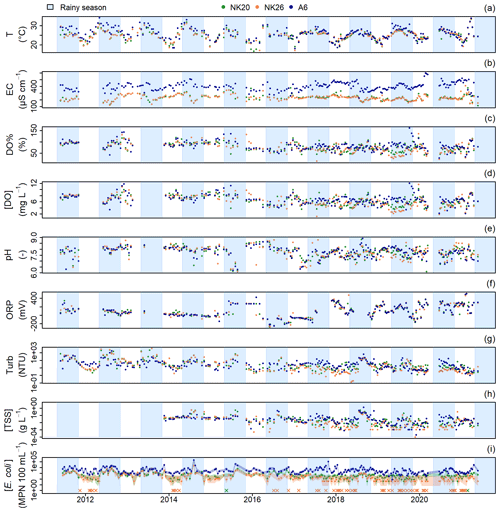
Figure 3Stream water quality from 2011 to 2021 along the Nam Khan river (sampling stations NK20 and NK26) and its tributary Houay Khan (sampling station A6), northern Lao PDR. T: temperature (∘C); EC: electrical conductance at 25 ∘C (µS cm−1); DO%: oxygen saturation (%); [DO]: oxygen concentration (mg L−1); pH: pH (–); ORP: oxidation-reduction potential (mV); Turb: turbidity (NTU); [TSS]: total suspended sediment concentration (g L−1); [E. coli]: Escherichia coli concentration (MPN 100 mL−1) with lower and upper limits of the confidence interval given by Poisson distribution using the standardized microplate method. Turb, [TSS], and [E. coli] are shown with y axis as log scale. We added 0.0001 and 1 to all [TSS] and [E. coli] values, respectively, to present 0 values in a log scale, by convention. Crosses for [E. coli] represent [E. coli] below the detection limit. Blue polygons represent the rainy season from May to October.
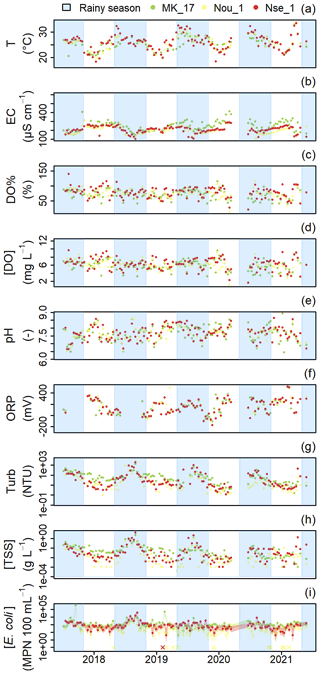
Figure 4Stream water quality from 2017 to 2021 in the Mekong River at Luang Prabang (sampling station MK_17) and its tributaries Nam Ou and Nam Seuang (sampling stations Nou_1 and Nse_1, respectively), northern Lao PDR. T: temperature (∘C); EC: electrical conductance at 25 ∘C (µS cm−1); DO%: oxygen saturation (%); [DO]: oxygen concentration (mg L−1); pH: pH (–); ORP: oxidation-reduction potential (mV); Turb: turbidity (NTU); [TSS]: total suspended sediment concentration (g L−1); [E. coli]: Escherichia coli concentration (MPN 100 mL−1) with lower and upper limits of the confidence interval given by Poisson distribution using the standardized microplate method. Turb, [TSS], and [E. coli] are shown with y axis as log scale. We added 0.0001 and 1 to all [TSS] and [E. coli] values, respectively, to present 0 values in a log scale, by convention. Crosses for [E. coli] represent [E. coli] below the detection limit. Blue polygons represent the rainy season from May to October.
The spatial survey (Ribolzi et al., 2021c) conducted in both the dry and the rainy seasons in 2016 resulted in 58 records (Fig. 2). The dataset shows contrasted values of [E. coli] depending on the season (Nakhle et al., 2021b). Median values of [E. coli] are higher during the rainy season, similar to [TSS], Turb, ORP, and T, while EC, DO%, and pH show smaller median values during the rainy season compared to the dry season.
The temporal monitoring at the outlet of the six catchments (Ribolzi et al., 2021a), initiated in May 2011 at stations NK20, NK26, and A6 (Fig. 3), and in July 2017 at stations Nou_1, Nse_1, and MK_17 (Fig. 4), resulted in 1131 records until May 2021. The dataset shows seasonal variations of [E. coli] and of the other variables (Boithias et al., 2016). In general, T and EC were increasing throughout the dry season and decreasing throughout the rainy season. The highest and lowest values of Turb, [TSS], and [E. coli], were measured during the rainy and the dry seasons, respectively. The temporal dynamics of DO%, [DO], pH, and ORP, are less clear. At station NK26 the number of water samples with [E. coli] below the detection limit increased after 2016 (Fig. 3). The data gap between 12 March and 20 June 2020, is due to the COVID-19 lockdown and traffic restrictions.
The temporal monitoring at station S4, outlet of the Houay Pano headwater catchment (Ribolzi et al., 2021b), initiated in May 2011, resulted in 413 records until May 2021 (Fig. 5). The dataset shows seasonal variations of [E. coli] and of the other variables (Boithias et al., 2016). Similar to the large catchments, T and EC were generally increasing throughout the dry season and decreasing throughout the rainy season. The highest and lowest values of Turb, [TSS], and [E. coli], were measured during the rainy and the dry seasons, respectively. The temporal dynamics of DO%, [DO], pH, and ORP, are less clear. We monitored [E. coli] dynamics during 14 flood events (Boithias et al., 2021a). Values of [E. coli] measured during flood events with the automatic sampler are generally higher than those measured during low-flow periods in grab samples.
We calibrated the multi-probe system each day before measurement, i.e., every day during the spatial survey (Ribolzi et al., 2021c), and at a biweekly or 10 d frequency for the two other datasets (Ribolzi et al., 2021b, a). The EC probe was calibrated with a 1413 µS cm−1 solution, and the [DO] probe was calibrated following the air-calibration chamber in air method (USGS, 2006). The DO% was then automatically calibrated based on [DO] and the barometric pressure. The pH probe was calibrated using a three-point calibration (pH = 4.01, 7.01, and 9.18). The ORP probe was calibrated with a 240 mV solution. For the turbidity meter, each day before measurement, we verified that the turbidity measured using the 100 NTU calibration solution was correct. If a discrepancy was observed, we calibrated the turbidity meter with 4 calibration solutions at 0.02, 20, 100, and 800 NTU. The accuracy of the suspended sediment mass on the 0.2 µm filters was ensured by the use of a 10−4 g precision balance. We assessed the uncertainty of [E. coli] by using the MPN statistical method, which supplies the upper and lower limits of the confidence interval.
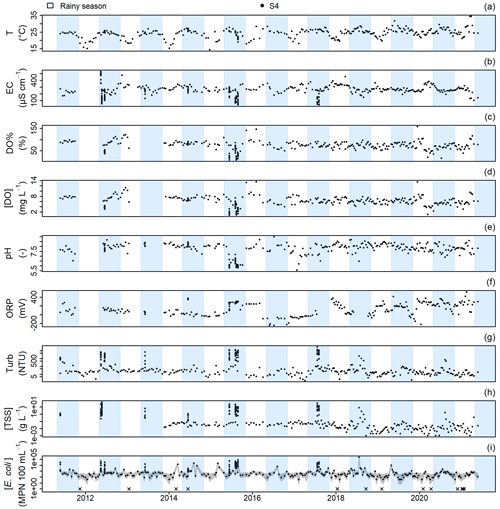
Figure 5Stream water quality from 2011 to 2021 at the outlet of the Houay Pano catchment (sampling station S4), northern Lao PDR. T: temperature (∘C); EC: electrical conductance at 25 ∘C (µS cm−1); DO%: oxygen saturation (%); [DO]: oxygen concentration (mg L−1); pH: pH (–); ORP: oxidation-reduction potential (mV); Turb: turbidity (NTU); [TSS]: total suspended sediment concentration (g L−1); [E. coli]: Escherichia coli concentration (MPN 100 mL−1) with lower and upper limits of the confidence interval given by Poisson distribution using the standardized microplate method. Turb, [TSS], and [E. coli] are shown with y axis as log scale. We added 0.0001 and 1 to all [TSS] and [E. coli] values, respectively, to present 0 values in a log scale, by convention. Crosses for [E. coli] represent [E. coli] below the detection limit. Blue polygons represent the rainy season from May to October.
We collected water samples as far as possible from the stream bank, to avoid any influence of the latter. Similarly, we chose sampling stations so as to not be affected by an upstream confluence. Physicochemistry and suspended sediment concentration can be heterogeneous along a stream cross-section (Santini et al., 2019), but for reasons of logistical capacity of sampling, the measurements could only be made from a single sample at the different stations. However, to ensure that measurements at the sampling point were within the range of variation of the values measured along the stream cross-section, we performed a 10-point survey across the river section at station NK20, which is a referenced station of the Lao PDR national hydrological monitoring network (Ribolzi et al., 2022).
Before laboratory analysis, water samples were stored in clean plastic bottles. These bottles were new empty bottles, supplied by a plastic bottle plant producing bottles for mineral water packaging. We regularly verified that the bottles were free from E. coli, and we triple rinsed the bottles with stream water before each water sampling.
Records were collated, curated, and cross-checked. If the information recorded in the databases was ambiguous or did not match between records, we traced the sample back using the original paper records as far as possible. Samples which could not be verified in this way were excluded from publication in the current dataset.
We published the three datasets as CSV files so that they can be accessed and processed with any data-processing software. The three datasets are open access, licensed under a Creative Commons Attribution 4.0 International License. For the proper functioning and the sustainability of the CZO, M-TROPICS asks data users to (1) acknowledge the M-TROPICS CZO and its financing institutions in their publications, (2) cite both the appropriate DOI of the data they used and the related publications, and (3) send a copy of any produced material based on the data to the corresponding authors of the present data description paper (LB and/or OR). The corresponding authors, who are intimately familiar with the background of these datasets, are at the disposal of the researchers wishing to reuse the datasets.
The database includes a total of 1602 records and is publicly available online as a collection of three files (Ribolzi et al., 2021b, a, c) hosted within the DataSuds platform (https://dataverse.ird.fr/, last access: 21 June 2022). The three repositories are:
-
Escherichia coli concentrations and physicochemical measurements at the outlet of 29 catchments of the Mekong River basin, Lao PDR, during dry and rainy seasons (2016) (Ribolzi et al., 2021c): https://doi.org/10.23708/ZRSBM4;
-
Escherichia coli concentrations and physicochemical measurements (2011–2021) at the outlet of six catchments of the Mekong River basin, northern Lao PDR (Ribolzi et al., 2021a): https://doi.org/10.23708/1YZQHH;
-
Escherichia coli concentrations and physicochemical measurements (2011–2021) at the outlet of the Houay Pano catchment, northern Lao PDR (Ribolzi et al., 2021b): https://doi.org/10.23708/EWOYNK.
We published the three datasets as CSV files and a data dictionary along with the data files. The column headings of the data dictionary files are listed in Table 2, along with the unit of each variable.
These three datasets together present a unique long-term spatiotemporal and multiscale surface water quality monitoring within the Mekong River basin. So far, the datasets have been used: (1) to describe the hydrological processes driving in-stream E. coli concentration during flood events (Boithias et al., 2021a; Ribolzi et al., 2016b), (2) to understand the role of land use in bacterial dissemination on small and large catchment scales, e.g., E. coli (Causse et al., 2015; Rochelle-Newall et al., 2016; Nakhle et al., 2021b; Ribolzi et al., 2011) and Burkholderia pseudomallei (Ribolzi et al., 2016a; Zimmermann et al., 2018; Liechti et al., 2021), (3) to relate stream water quality and diarrhea outbreaks (Boithias et al., 2016), and (4) to build catchment-scale numerical models focused on water quality (Kim et al., 2017, 2018; Abbas et al., 2021, 2022). The dataset may be further used (1) to assess the role of headwater catchments as a source of E. coli in large tropical river basins, (2) to interpret new variables measured in the monitored catchments (e.g., contaminants other than E. coli), (3) to assess the impact of dams on downstream E. coli concentration, (4) to map the health risk posed by fecal pathogens, and (5) to assess the relative contributions of both climate and land-use change on changes in instream E. coli concentration.
OR designed the study. LB, OR, and APB coordinated the project. OR, RZ, SR, PO, and APB collected water samples and performed field measurements for dataset https://doi.org/10.23708/ZRSBM4 (Ribolzi et al., 2021c). LB, OR, CT, BS, KL, NoS, PS, KX, JC, and THdT collected water samples and performed field measurements for dataset https://doi.org/10.23708/1YZQHH (Ribolzi et al., 2021a). LB, OR, ERN, CT, BS, KL, NoS, PS, KX, TP, OE, and SH collected water samples and performed field measurements for dataset https://doi.org/10.23708/EWOYNK (Ribolzi et al., 2021b). CT and APB performed microbial laboratory analysis. LB and OR validated the data and curated the database. LB, OR, ERN, and PN analyzed the data. OS and NiS provided institutional support. LB wrote the original draft of the manuscript. All other authors reviewed and edited the manuscript.
The contact author has declared that neither they nor their co-authors have any competing interests.
Publisher's note: Copernicus Publications remains neutral with regard to jurisdictional claims in published maps and institutional affiliations.
These three datasets have been collected thanks to the long-term partnership with the Department of Agricultural Land Management (DALaM), Lao PDR, which granted the permission for field access, and to the financial, scientific, technical, and logistical support of the Multiscale TROPIcal CatchmentS Critical Zone Observatory (M-TROPICS CZO, previously MSEC; https://mtropics.obs-mip.fr/, last access: 21 June 2022).
This research has been supported by the Consultative Group on International Agricultural Research (CGIAR; Humidtropics program; http://humidtropics.cgiar.org/, last access: 21 June 2022), the GIS-Climat (Pastek program, http://www.gisclimat.fr/projet/pastek.html, last access: 21 June 2022), the French National Research Agency (TecItEasy project ANR-13-AGRO-0007; https://anr.fr/, last access: 21 June 2022), the Institut de Recherche pour le Développement (IRD), including through the International Joint Laboratory on the impact of rapid Land-use change on Soil Ecosystem Services (LMI LUSES; ECOFILTER program; https://luses.ird.fr/, last access: 21 June 2022) and the regional pilot program Soils, Waters, Coastal Zones and Societies in Southern and Southeast Asia (SELTAR-RPP), the International Center for Tropical Agriculture (CIAT) through the Payment for Environmental Services (PES) program in Lao PDR, the French Centre National de la Recherche Scientifique (CNRS) through the national grants EC2CO-Biohefect/Ecodyn//Dril/MicrobiEn (Belcrue, Belkong, and NARIBACT projects), the US Defence Threat Reduction Agency's Cooperative Biological Engagement Program (contract HDTRA-16-C-0017), the Lao-Oxford-Mahosot Hospital-Wellcome Trust Research Unit funded by the Wellcome Trust of Great Britain (grant no. 089275/H/09/Z), the Li Ka Shing Foundation of the University of Oxford (grant SM40), and the Nam Theun 2 Power Company (NTPC).
This paper was edited by David Carlson and reviewed by two anonymous referees.
Abbas, A., Baek, S., Silvera, N., Soulileuth, B., Pachepsky, Y., Ribolzi, O., Boithias, L., and Cho, K. H.: In-stream Escherichia coli modeling using high-temporal-resolution data with deep learning and process-based models, Hydrol. Earth Syst. Sci., 25, 6185–6202, https://doi.org/10.5194/hess-25-6185-2021, 2021.
Abbas, A., Boithias, L., Pachepsky, Y., Kim, K., Chun, J. A., and Cho, K. H.: AI4Water v1.0: an open-source python package for modeling hydrological time series using data-driven methods, Geosci. Model Dev., 15, 3021–3039, https://doi.org/10.5194/gmd-15-3021-2022, 2022.
Arias, M. E., Cochrane, T. A., Kummu, M., Lauri, H., Holtgrieve, G. W., Koponen, J., and Piman, T.: Impacts of hydropower and climate change on drivers of ecological productivity of Southeast Asia's most important wetland, Ecol. Model., 272, 252–263, https://doi.org/10.1016/j.ecolmodel.2013.10.015, 2014.
Boithias, L., Choisy, M., Souliyaseng, N., Jourdren, M., Quet, F., Buisson, Y., Thammahacksa, C., Silvera, N., Latsachack, K., Sengtaheuanghoung, O., Pierret, A., Rochelle-Newall, E., Becerra, S., and Ribolzi, O.: Hydrological regime and water shortage as drivers of the seasonal incidence of diarrheal diseases in a tropical montane environment, PLoS Negl. Trop. Dis., 10, e0005195, https://doi.org/10.1371/journal.pntd.0005195, 2016.
Boithias, L., Ribolzi, O., Lacombe, G., Thammahacksa, C., Silvera, N., Latsachack, K., Soulileuth, B., Viguier, M., Auda, Y., Robert, E., Evrard, O., Huon, S., Pommier, T., Zouiten, C., Sengtaheuanghoung, O., and Rochelle-Newall, E.: Quantifying the effect of overland flow on Escherichia coli pulses during floods: Use of a tracer-based approach in an erosion-prone tropical catchment, J. Hydrol., 594, 125935, https://doi.org/10.1016/j.jhydrol.2020.125935, 2021a.
Boithias, L., Auda, Y., Audry, S., Bricquet, J., Chanhphengxay, A., Chaplot, V., de Rouw, A., Henry des Tureaux, T., Huon, S., Janeau, J., Latsachack, K., Le Troquer, Y., Lestrelin, G., Maeght, J., Marchand, P., Moreau, P., Noble, A., Pando-Bahuon, A., Phachomphon, K., Phanthavong, K., Pierret, A., Ribolzi, O., Riotte, J., Robain, H., Rochelle-Newall, E., Sayavong, S., Sengtaheuanghoung, O., Silvera, N., Sipaseuth, N., Soulileuth, B., Souliyavongsa, X., Sounyaphong, P., Tasaketh, S., Thammahacksa, C., Thiebaux, J., Valentin, C., Vigiak, O., Viguier, M., and Xayyathip, K.: The Multiscale TROPIcal CatchmentS critical zone observatory M-TROPICS dataset II: land use, hydrology and sediment production monitoring in Houay Pano, northern Lao PDR, Hydrol. Process., 35, e14126, https://doi.org/10.1002/hyp.14126, 2021b.
Causse, J., Billen, G., Garnier, J., Henri-des-Tureaux, T., Olasa, X., Thammahacksa, C., Latsachak, K. O., Soulileuth, B., Sengtaheuanghoung, O., Rochelle-Newall, E., and Ribolzi, O.: Field and modelling studies of Escherichia coli loads in tropical streams of montane agro-ecosystems, J. Hydro-Environ. Res., 9, 496–507, https://doi.org/10.1016/j.jher.2015.03.003, 2015.
Chaplot, V. and Poesen, J.: Sediment, soil organic carbon and runoff delivery at various spatial scales, Catena, 88, 46–56, https://doi.org/10.1016/j.catena.2011.09.004, 2012.
Exley, J. L. R., Liseka, B., Cumming, O., and Ensink, J. H. J.: The Sanitation Ladder, What Constitutes an Improved Form of Sanitation?, Environ. Sci. Technol., 49, 1086–1094, https://doi.org/10.1021/es503945x, 2015.
Gaillardet, J., Braud, I., Hankard, F., Anquetin, S., Bour, O., Dorfliger, N., de Dreuzy, J.R., Galle, S., Galy, C., Gogo, S., Gourcy, L., Habets, F., Laggoun, F., Longuevergne, L., Le Borgne, T., Naaim-Bouvet, F., Nord, G., Simonneaux, V., Six, D., Tallec, T., Valentin, C., Abril, G., Allemand, P., Arènes, A., Arfib, B., Arnaud, L., Arnaud, N., Arnaud, P., Audry, S., Comte, V.B., Batiot, C., Battais, A., Bellot, H., Bernard, E., Bertrand, C., Bessière, H., Binet, S., Bodin, J., Bodin, X., Boithias, L., Bouchez, J., Boudevillain, B., Moussa, I.B., Branger, F., Braun, J.J., Brunet, P., Caceres, B., Calmels, D., Cappelaere, B., Celle-Jeanton, H., Chabaux, F., Chalikakis, K., Champollion, C., Copard, Y., Cotel, C., Davy, P., Deline, P., Delrieu, G., Demarty, J., Dessert, C., Dumont, M., Emblanch, C., Ezzahar, J., Estèves, M., Favier, V., Faucheux, M., Filizola, N., Flammarion, P., Floury, P., Fovet, O., Fournier, M., Francez, A.J., Gandois, L., Gascuel, C., Gayer, E., Genthon, C., Gérard, M.F., Gilbert, D., Gouttevin, I., Grippa, M., Gruau, G., Jardani, A., Jeanneau, L., Join, J.L., Jourde, H., Karbou, F., Labat, D., Lagadeuc, Y., Lajeunesse, E., Lastennet, R., Lavado, W., Lawin, E., Lebel, T., Le Bouteiller, C., Legout, C., Lejeune, Y., Le Meur, E., Le Moigne, N., Lions, J., Lucas, A., Malet, J.P., Marais-Sicre, C., Maréchal, J.C., Marlin, C., Martin, P., Martins, J., Martinez, J.M., Massei, N., Mauclerc, A., Mazzilli, N., Molénat, J., Moreira-Turcq, P., Mougin, E., Morin, S., Ngoupayou, J.N., Panthou, G., Peugeot, C., Picard, G., Pierret, M.C., Porel, G., Probst, A., Probst, J.L., Rabatel, A., Raclot, D., Ravanel, L., Rejiba, F., René, P., Ribolzi, O., Riotte, J., Rivière, A., Robain, H., Ruiz, L., Sanchez-Perez, J.M., Santini, W., Sauvage, S., Schoeneich, P., Seidel, J.L., Sekhar, M., Sengtaheuanghoung, O., Silvera, N., Steinmann, M., Soruco, A., Tallec, G., Thibert, E., Lao, D.V., Vincent, C., Viville, D., Wagnon, P., and Zitouna, R.: OZCAR: The French Network of Critical Zone Observatories, Vadose Zone J., 17, 180067, https://doi.org/10.2136/vzj2018.04.0067, 2018.
Global Water Forum: Basins under pressure: the Mekong basin, 47 pp., 2015.
Hecht, J. S., Lacombe, G., Arias, M. E., Dang, T. D., and Piman, T.: Hydropower dams of the Mekong River basin: A review of their hydrological impacts, J. Hydrol., 568, 285–300, https://doi.org/10.1016/j.jhydrol.2018.10.045, 2019.
Kim, M., Boithias, L., Cho, K. H., Silvera, N., Thammahacksa, C., Latsachack, K., Rochelle-Newall, E., Sengtaheuanghoung, O., Pierret, A., Pachepsky, Y. A., and Ribolzi, O.: Hydrological modeling of Fecal Indicator Bacteria in a tropical mountain catchment, Water Res., 119, 102–113, https://doi.org/10.1016/j.watres.2017.04.038, 2017.
Kim, M., Boithias, L., Cho, K. H., Sengtaheuanghoung, O., and Ribolzi, O.: Modeling the Impact of Land Use Change on Basin-scale Transfer of Fecal Indicator Bacteria: SWAT Model Performance, J. Environ. Qual., 47, 1115–1122, https://doi.org/10.2134/jeq2017.11.0456, 2018.
Kondolf, G. M., Rubin, Z. K., and Minear, J. T.: Dams on the Mekong: Cumulative sediment starvation, Water Resour. Res., 50, 5158–5169, https://doi.org/10.1002/2013WR014651, 2014.
Lao Statistics Bureau: Results of Population and Housing Census 2015 – The 4th Population and Housing Census (PHC), 282 pp., 2015.
Le Meur, M., Le Phu, V., and Nicolas, G.: What Is the Future of the Lower Mekong Basin Struggling against Human Activities? A Review, in: River Deltas – Recent Advances, IntechOpen, https://doi.org/10.5772/intechopen.95010, 2021.
Liechti, N., Zimmermann, R. E., Zopfi, J., Robinson, M. T., Pierret, A., Ribolzi, O., Rattanavong, S., Davong, V., Newton, P. N., Wittwer, M., and Dance, D. A. B.: Whole-Genome Assemblies of 16 Burkholderia pseudomallei Isolates from Rivers in Laos, Microbiol. Resour. Announc., 10, e01226-20, https://doi.org/10.1128/MRA.01226-20, 2021.
Lyon, S. W., King, K., Polpanich, O., and Lacombe, G.: Assessing hydrologic changes across the Lower Mekong Basin, J. Hydrol. Reg. Stud., 12, 303–314, https://doi.org/10.1016/j.ejrh.2017.06.007, 2017.
MA: Millennium Ecosystem Assessment, Ecosystems and Human Well-being: Synthesis, Island Press/World Resources Institute, Washington DC, 155 pp., 2005.
MRC: The flow of the Mekong, Mekong River Commission Management Information Booklet Series No. 2, 12 pp., 2009.
Nakhle, P., Boithias, L., Pando-Bahuon, A., Thammahacksa, C., Gallion, N., Sounyafong, P., Silvera, N., Latsachack, K., Soulileuth, B., Rochelle-Newall, E. J., Marcangeli, Y., Pierret, A., and Ribolzi, O.: Decay Rate of Escherichia coli in a Mountainous Tropical Headwater Wetland, Water, 13, 2068, https://doi.org/10.3390/w13152068, 2021a.
Nakhle, P., Ribolzi, O., Boithias, L., Rattanavong, S., Auda, Y., Sayavong, S., Zimmermann, R., Soulileuth, B., Pando, A., Thammahacksa, C., Rochelle-Newall, E., Santini, W., Martinez, J. M., Gratiot, N., and Pierret, A.: Effects of hydrological regime and land use on in-stream Escherichia coli concentration in the Mekong basin, Lao PDR, Sci. Rep., 11, 3460, https://doi.org/10.1038/s41598-021-82891-0, 2021b.
Pokhrel, Y., Burbano, M., Roush, J., Kang, H., Sridhar, V., and Hyndman, D.: A Review of the Integrated Effects of Changing Climate, Land Use, and Dams on Mekong River Hydrology, Water, 10, 266, https://doi.org/10.3390/w10030266, 2018.
Ribolzi, O., Cuny, J., Sengsoulichanh, P., Mousquès, C., Soulileuth, B., Pierret, A., Huon, S., and Sengtaheuanghoung, O.: Land Use and Water Quality Along a Mekong Tributary in Northern Lao P.D.R., Environ. Manage., 47, 291–302, https://doi.org/10.1007/s00267-010-9593-0, 2011.
Ribolzi, O., Rochelle-Newall, E., Dittrich, S., Auda, Y., Newton, P. N., Rattanavong, S., Knappik, M., Soulileuth, B., Sengtaheuanghoung, O., Dance, D. A. B., and Pierret, A.: Land use and soil type determine the presence of the pathogen Burkholderia pseudomallei in tropical rivers, Environ. Sci. Pollut. Res., 23, 7828–7839, https://doi.org/10.1007/s11356-015-5943-z, 2016a.
Ribolzi, O., Evrard, O., Huon, S., Rochelle-Newall, E., Henri-des-Tureaux, T., Silvera, N., Thammahacksac, C., and Sengtaheuanghoung, O.: Use of fallout radionuclides (7Be, 210Pb) to estimate resuspension of Escherichia coli from streambed sediments during floods in a tropical montane catchment, Environ. Sci.Pollut. Res., 23, 3427–3435, https://doi.org/10.1007/s11356-015-5595-z, 2016b.
Ribolzi, O., Evrard, O., Huon, S., de Rouw, A., Silvera, N., Latsachack, K. O., Soulileuth, B., Lefèvre, I., Pierret, A., Lacombe, G., Sengtaheuanghoung, O., and Valentin, C.: From shifting cultivation to teak plantation: effect on overland flow and sediment yield in a montane tropical catchment, Sci. Rep., 7, 3987, https://doi.org/10.1038/s41598-017-04385-2, 2017.
Ribolzi, O., Boithias, L., Thammahacksa, C., Silvera, N., Pando-Bahuon, A., Sengtaheuanghoung, O., Sipaseuth, N., Latsachack, K., Soulileuth, B., Sounyafong, P., Khampaseuth, X., and Pierret, A.: Escherichia coli concentrations and physico-chemical measurements (2011–2021) at the outlet of six catchments of the Mekong river basin, northern Lao PDR, DataSuds, V3 [data set], https://doi.org/10.23708/1YZQHH, 2021a.
Ribolzi, O., Boithias, L., Thammahacksa, C., Rochelle-Newall, E., Pando-Bahuon, A., Silvera, N., Sengtaheuanghoung, O., Sipaseuth, N., and Pierret, A.: Escherichia coli concentrations and physico-chemical measurements (2011–2021) at the outlet of the Houay Pano catchment, northern Lao PDR, DataSuds, V3 [data set], https://doi.org/10.23708/EWOYNK, 2021b.
Ribolzi, O., Zimmermann, R., Thammahacksa, C., Rattanavong, S., Oliva, P., Sengtaheuanghoung, O., and Pierret, A.: Escherichia coli concentrations and physico-chemical measurements at the outlet of 29 catchments of the Mekong river basin, Lao PDR, during dry and rainy seasons (2016), DataSuds, V3 [data set], https://doi.org/10.23708/ZRSBM4, 2021c.
Ribolzi, O., Causse, J., Thammahacksa, C., Latsachack, K., Huon, S., Henry-Des-Tureaux, T., Sengtaheuanghoung, O., Sipaseuth, N., and Pierret, A.: Escherichia coli concentrations and physico-chemical measurements (2011) along a cross-sectional profile of the Nam Khan river, Mekong river basin, northern Lao PDR, DataSuds, V3 [data set], https://doi.org/10.23708/RNY0LD, 2022.
Rochelle-Newall, E., Nguyen, T. M. H., Le, T. P. Q., Sengtaheuanghoung, O., and Ribolzi, O.: A short review of fecal indicator bacteria in tropical aquatic ecosystems: knowledge gaps and future directions, Front. Microbiol., 6, 308, https://doi.org/10.3389/fmicb.2015.00308, 2015.
Rochelle-Newall, E. J., Ribolzi, O., Viguier, M., Thammahacksa, C., Silvera, N., Latsachack, K., Dinh, R. P., Naporn, P., Sy, H. T., Soulileuth, B., Hmaimum, N., Sisouvanh, P., Robain, H., Janeau, J.-L., Valentin, C., Boithias, L., and Pierret, A.: Effect of land use and hydrological processes on Escherichia coli concentrations in streams of tropical, humid headwater catchments, Sci. Rep., 6, 32974, https://doi.org/10.1038/srep32974, 2016.
Sabo, J. L., Ruhi, A., Holtgrieve, G. W., Elliott, V., Arias, M. E., Ngor, P. B., Räsänen, T. A., and Nam, S.: Designing river flows to improve food security futures in the Lower Mekong Basin, Science, 358, eaao1053, https://doi.org/10.1126/science.aao1053, 2017.
Santini, W., Camenen, B., Le Coz, J., Vauchel, P., Guyot, J.-L., Lavado, W., Carranza, J., Paredes, M. A., Pérez Arévalo, J. J., Arévalo, N., Espinoza Villar, R., Julien, F., and Martinez, J.-M.: An index concentration method for suspended load monitoring in large rivers of the Amazonian foreland, Earth Surf. Dynam., 7, 515–536, https://doi.org/10.5194/esurf-7-515-2019, 2019.
Shrestha, B., Maskey, S., Babel, M. S., van Griensven, A., and Uhlenbrook, S.: Sediment related impacts of climate change and reservoir development in the Lower Mekong River Basin: a case study of the Nam Ou Basin, Lao PDR, Climatic Change, 149, 13–27, https://doi.org/10.1007/s10584-016-1874-z, 2018.
Tong, Y., Yao, R., He, W., Zhou, F., Chen, C., Liu, X., Lu, Y., Zhang, W., Wang, X., Lin, Y., and Zhou, M.: Impacts of sanitation upgrading to the decrease of fecal coliforms entering into the environment in China, Environ. Res., 149, 57–65, https://doi.org/10.1016/j.envres.2016.05.009, 2016.
USGS: Dissolved oxygen: U.S. Geological Survey Techniques and Methods, book 9, chap. A6.2, version 2.0., 48 pp., https://doi.org/10.3133/tm9A6.2, 2006.
Vos, T., Lim, S. S., Abbafati, C., Abbas, K. M., Abbasi, M., Abbasifard, M., Abbasi-Kangevari, M., Abbastabar, H., Abd-Allah, F., Abdelalim, A., Abdollahi, M., Abdollahpour, I., Abo lhassani, H., Aboyans, V., Abrams, E. M., Abreu, L. G., Abrigo, M. R. M., Abu-Raddad, L. J., Abushouk, A. I., Acebedo, A., Ackerman, I. N., Adabi, M., Adamu, A. A., Adebayo, O. M., Adekanmbi, V., Adelson, J. D., Adetokunboh, O. O., Adham, D., Afshari, M., Afshin, A., Agardh, E. E., Agarwal, G., Agesa, K. M., Aghaali, M., Aghamir, S. M. K., Agrawal, A., Ahmad, T., Ahmadi, A., Ahmadi, M., Ahmadieh, H., Ahmadpour, E., Akalu, T. Y., Akinyemi, R. O., Akinyemiju, T., Akombi, B., Al-Aly, Z., Alam, K., Alam, N., Alam, S., Alam, T., Alanzi, T. M., Albertson, S. B., Alcalde-Rabanal, J. E., Alema, N. M., Ali, M., Ali, S., Alicandro, G., Alijanzadeh, M., Alinia, C., Alipour, V., Aljunid, S. M., Alla, F., Allebeck, P., Almasi-Hashiani, A., Alonso, J., Al-Raddadi, R. M., Altirkawi, K. A., Alvis-Guzman, N., Alvis-Zakzuk, N. J., Amini, S., Amini-Rarani, M., Aminorroaya, A., Amiri, F., Amit, A. M. L., Amugsi, D. A., Amul, G. G. H., Anderlini, D., Andrei, C. L., Andrei, T., Anjomshoa, M., Ansari, F., Ansari, I., Ansari-Moghaddam, A., Antonio, C. A. T., Antony, C. M., Antriyandarti, E., Anvari, D., Anwer, R., Arabloo, J., Arab-Zozani, M., Aravkin, A. Y., Ariani, F., Ärnlöv, J., Aryal, K. K., Arzani, A., Asadi-Aliabadi, M., Asadi-Pooya, A. A., Asghari, B., Ashbaugh, C., et al.: Global burden of 369 diseases and injuries in 204 countries and territories, 1990–2019: a systematic analysis for the Global Burden of Disease Study 2019, The Lancet, 396, 1204–1222, https://doi.org/10.1016/S0140-6736(20)30925-9, 2020.
WLE: Dataset on the Dams of the Irrawaddy, Mekong, Red and Salween River Basins, Vientiane, Lao PDR: CGIAR Research Program on Water, Land and Ecosystems – Greater Mekong, https://wle-mekong.cgiar.org/maps/, last access: 21 June 2022.
Zimmermann, R. E., Ribolzi, O., Pierret, A., Rattanavong, S., Robinson, M. T., Newton, P. N., Davong, V., Auda, Y., Zopfi, J., and Dance, D. A. B.: Rivers as carriers and potential sentinels for Burkholderia pseudomallei in Laos, Sci. Rep., 8, 8674, https://doi.org/10.1038/s41598-018-26684-y, 2018.





